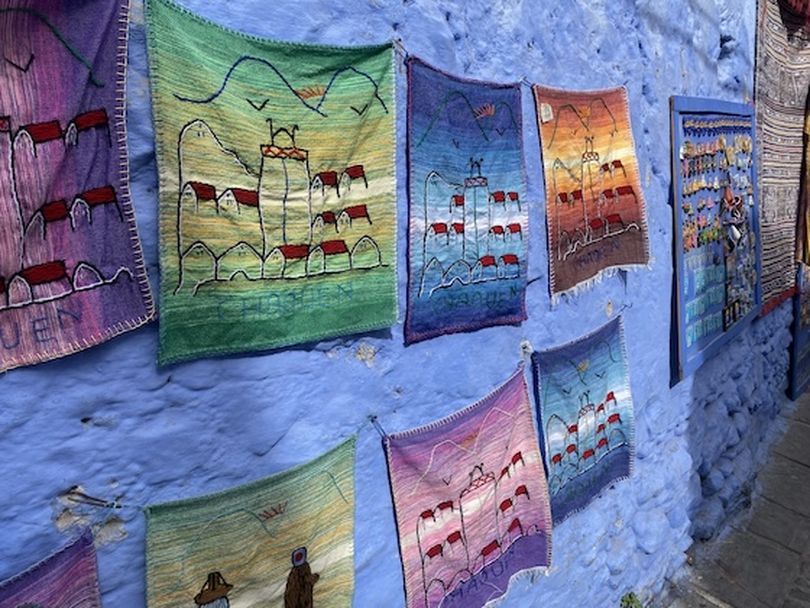Food is the universal language for travelers

It was an October afternoon in 2019, and I was about to do something that made me nervous.
That could cover a lot of topics, I know. But this one involved attempting to make a restaurant reservation in a foreign language. And not even the foreign language I am most familiar with.
This was in Morocco, in the famous Blue City of Chefchaouen (also referred to as “the Blue Pearl”). My wife, Mary Pat Treuthart, and I had traveled there in the midst of a three-week sojourn through the country.
That sojourn ultimately took us everywhere from the Mediterranean port city of Tangier through any number of other cities big and small – among them Fes, Rabat, Marrakesh and Casablanca (where, indeed, we did sample the waters) – and on to the Atlas Mountains and the edge of the Sahara Desert.
Chefchaouen dates back some 600 years, when it was founded as a fort. But it soon became a refuge for those of both Muslim and Jewish faiths expelled from Spain. The name of the town itself refers to the two mountaintops that the city sits between (the name Chefchaouen is said to be Berber for “the two horns”).
I had no interest in driving around Morocco, some of the roads being barely paved paths of dirt and mud (and the city parking far too complicated for me to figure out, especially in Fes and Marrakesh). So, we traveled either by train or by private drivers (arrangements that were easy to make online – or through our hotels).
The driver that we had hired on this occasion had dropped us off near the city center and helped us find our lodging, a third-floor rented room. Though it was set just off a busy alleyway, it was quiet and comfortable enough, even if Chefchaouen tends to come alive at night.
This is true even though the city isn’t that big. Wikipedia lists the population as only 43,000, but much of that population is packed into a relatively small area (add to that, presumably, tourists just like us). As Morocco’s national tourist office makes clear, you can spend hours just walking the winding streets, most of which offer an array of traditional arts and crafts for sale.
The tourist office also lists a number of outdoor activities as well, from hikes to river rafting, etc. Other websites recommend visiting both an abandoned Spanish Mosque that overlooks the city and the Akchour waterfalls in nearby Talassemtane National Park.
We had only one full day to spend there, however, and so were content simply to walk the streets, explore the Medina (the historic walled section of any Arab city) and the Kasbah (the original fort around which the city grew).
And, of course, find intriguing places to eat.
On the second of our two-night stay, we wanted to dine at a rooftop restaurant that overlooks the city’s main plaza. But that meant that we had to find a way to reserve just the right table. And that, I was fairly certain, would be a problem.
A note regarding language in Morocco: Wikipedia refers to a 2012 report by the Spanish government that says 98 percent of Moroccans speak Moroccan Arabic, 63 percent speak French, 26 percent Berber, 14 percent English, and 10 percent Spanish.
We’d had some success with English in the bigger cities. But as in most foreign countries, even those in Europe, the smaller towns and villages are different. And since neither of us have any Arabic beyond “inshallah,” that left the communication to my elementary French.
And as I wrote above, French isn’t even my first second language. Or my third, for that matter. I studied Spanish in college, and I’ve taken Italian classes in Florence to the point where I can – with a dictionary – order fairly comfortably in any restaurant from Palermo to Milan.
But French? Non. So I worked out what I wanted to say, practiced it, and then walked to the restaurant we had chosen and found what I assumed was a waiter.
It went well. At least it seemed to. I told the guy that we wanted to reserve a table, on the roof, at 7. And he listened to me, smiled and nodded when I finished. “Oui, oui,” he said, as I thanked him – “Merci, monsieur, merci” – and exited.
I was worried, though. Did I get my message across. Did the guy understand what I wanted? Was he even the right guy?
All that was running though my head as, just before 7, we walked across the plaza and entered the front door. And there he was, the same guy, smiling to me in greeting – I think he even laughed – and escorted us up the stairs to a table perfectly set for us to see out over the city below.
I don’t even remember what we ordered, though it was probably a mix of the same kind of Moroccan dishes that we’d been eating elsewhere, meaning mint tea, the mix of vegetables and meats in a tangine, couscous and more.
But I didn’t care. I’d spoken a foreign language, made myself understood, and gotten what I wanted.
The moon was out, the air was warm, the night was alive. Life was good.
